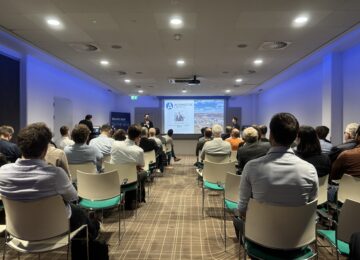RoyalHaskoning study: more focus on battery safety is needed
As part of the Dutch Batteries Strategy, the Ministry of Infrastructure and Water Management has commissioned a study by RoyalHaskoning on the development of safety in energy storage systems. The purpose of the study is to gain insight into the hazards of current Electricity Storage Systems (EOS) coming to the market in the next five to ten years and possibilities to prevent or reduce these hazards. In addition, the laws and regulations to control these hazards were analyzed. Energy Storage NL participated in the creation of the study.
Safety hazards
The research firm expects that in all likelihood - in the next five to 10 years - lithium-ion batteries will be dominant in the market and will be widely and commercially deployed. Lithium-ion batteries are still under development. Other technologies are emerging in the near term in the form of pilots or research. The hazard aspects of EOS depend on the technology and substances used. Briefly, these are:
- The greatest risk of lithium-ion batteries is the occurrence of a thermal runaway reaction due to cell failure. A thermal runaway is a reaction in which the increase in temperature further accelerates the reaction. This creates a kind of snowball effect that cannot be stopped. The effects that can occur during a thermal runaway are the release of a toxic and flammable gas composition, a battery fire and a vapor cloud explosion or cloud fire.
- The security risks of sodium ion batteries correspond to those of lithium-ion batteries. However, because the energy density of sodium-ion batteries is lower, both the probability of occurrence and severity of this thermal runaway, are less than for lithium-ion battery cells.
- Solid-state batteries have a similar thermal runaway hazard, but are safer because these batteries do not use a flammable liquid electrolyte. However, the risk of thermal runaway can never be completely eliminated in the chemistry of these batteries.
- At a redox flow battery the large amount of stored liquid toxic substances in storage tanks poses the greatest safety risk, as they could be released in an incident and toxic vapors would spread into the surrounding area. There is no risk of a thermal runaway.
- The fuel cells in hydrogen batteries are components that generate electricity from hydrogen and oxygen without combustion. Hydrogen is a highly flammable and explosive gas and ignites almost immediately upon release.
- At Sodium-Metal-Chloride batteries (SMC cells), a thermal runaway is possible, which causes complete combustion of the cells but will not result in an explosion or fire.
- Iron-oxygen batteries are safer due to the absence of flammable electrolytes or volatile components. These batteries are still in the research phase and the hazards have not yet been fully assessed. Risks seem to focus on oxygen displacement and formation of combustible clouds in a confined space.
Recommendations
Given the safety hazards associated with the above technologies, RoyalHaskoning comes up with the following recommendations:
- In terms of safe engineering, it is recommended that:
- Conduct unambiguous risk assessments (Technical Safety Reviews) for an EOS, preferably with a layer of protection analysis (LOPA, HAZOP, etc.), and visualization in a Bow-tie, meeting the safety requirement in the European Battery Regulation.
- In terms of legislation, more and more specific attention should be paid to safety around EOS. More specifically, it is recommended that:
- To designate at the national level the storage of energy carriers and the storage and/or use of EOS as an environmentally harmful activity in the Decree on activities in the living environment (Bal). The spatial incorporation of an EOS can be regulated at the municipal level through the environmental plan.
- To include a reference in the Occupational Health and Safety Decree to the Battery Ordinance, referring to the requirements regarding safety, inspection, soundness, maintenance, its communication and application, including a reference to the Bow-tie as a visualization of the risk assessment and assurance of safety per installation.
- Expand the scope of PGS 37-1 (and possibly PGS 37-2) to include several battery technologies that also have a risk of a thermal runaway.
- Establish a framework for conducting the specific risk assessment of each EOS, in line with the Battery Regulation, with minimum requirements for EOS and based on a system analysis: visualized in a Bow-tie per specific installation. The framework includes a version for the non-technically skilled and version with full details for the professional user and supervisor.
- In the area of knowledge building and communication to clarify legislation, it is recommended that:
- To conduct an investigation into the following questions: whether battery storage or use of an EOS falls within the scope of the Seveso establishment, and if so, whether Seveso thresholds can be exceeded and how this can be determined. Likewise, to raise this at the European level. This investigation could also involve whether and, if so, in what cases an EOS should fall under the ARIE regulation of the Occupational Health and Safety Decree.
- Conduct an investigation into whether technical building regulations in the Bbl can support the regulation of safety and environmental aspects in the Bal to mitigate risks and effects of the use of EOS.
- To examine the consequences for implementation in terms of knowledge and capacity at municipalities, environmental services and safety regions, in the event that EOS are designated (at the national or local level) as an environmentally harmful activity requiring a permit or notification.
- Establish a national knowledge infrastructure, with industry joining in, where information on EOS is publicly available to governments and initiators through one central location.
Networking meeting - security Feb. 8
Energy Storage NL is hosting a networking meeting on February 8 on the topic of Safety, where among other things, the commissioners of the safety study will come and talk about the main conclusions and recommendations. Would you like to attend? Then sign up through the following link: https://www.energystoragenl.nl/event/esnl-netwerkbijeenkomst-veiligheid-pgs-37/





